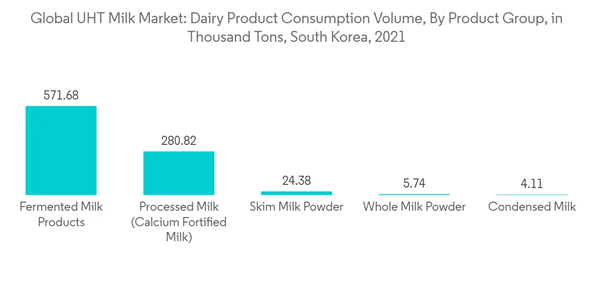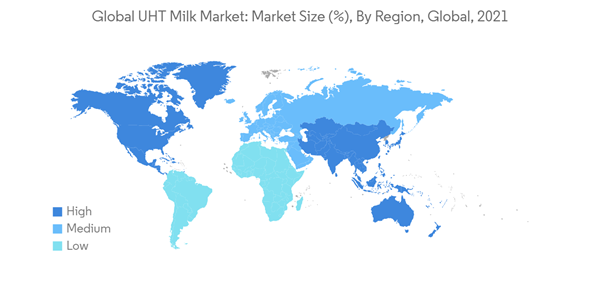The Global UHT Milk Market size is estimated at USD 64.24 billion in 2024, and is expected to reach USD 84.21 billion by 2029, growing at a CAGR of 5.56% during the forecast period (2024-2029).
UHT milk is made by heating milk at ultra-high temperatures for a fixed time. The high temperature kills all the microorganisms and spores and pasteurized the milk without destroying any nutrients. Due to the increase in the working population across the world, keeping milk stored and fresh for a long time is not easy. Also, due to small houses and less space, many households do not have refrigeration systems, because of which normal milk cannot be stored for a longer time. Thus, UHT milk can be stored at room temperature for a longer time, which is beneficial for smaller households as well as the working population. Furthermore, market players are also investing in the packaging of milk for a longer shelf life and better sustainability.
As UHT milk can be transported without cold chains, demand for it in restaurants, bars, and cafes is increasing. Additionally, the demand for lactose-free UHT milk is also increasing in many regions because of the prevalence of lactose intolerance among children and adults. Consumers these days are aware of their health and fitness. As a result, demand for full-cream milk and skim milk is also increasing, as they have a high amount of absorbable protein and are ideal for post-exercise recovery. The market players are constantly engaged in activities like mergers, acquisitions, and product launches to expand their portfolios. For instance, in April 2021, GEA Group India started to supply a complete ultra-high temperature production line for Creamy Foods, Uttar Pradesh, India. GEA supplies its UHT dairy products to Madhusudan, a Creamy Foods brand.
The UHT process retains all of the nutrients in milk and allows it to be stored at room temperature for extended periods without preservatives. In response to the growing demand for convenient and nutritious options, various companies have developed a line of UHT milk products enriched with vitamins and minerals to meet nutritional requirements for bodily functions. Lactose-free variants are also available, which cater to the specific needs of those with lactose intolerance. For instance, in January 2021, Stonyfield Organic launched a new organic, shelf-stable or UHT, lactose-free milk. The product is available in 2% reduced-fat chocolate milk and 2% reduced-fat plain milk. Furthermore, UHT milk is more convenient to use than regular fluid milk because it does not need refrigeration or heating before use, contributing to its popularity among young working people.
This product will be delivered within 2 business days.
UHT milk is made by heating milk at ultra-high temperatures for a fixed time. The high temperature kills all the microorganisms and spores and pasteurized the milk without destroying any nutrients. Due to the increase in the working population across the world, keeping milk stored and fresh for a long time is not easy. Also, due to small houses and less space, many households do not have refrigeration systems, because of which normal milk cannot be stored for a longer time. Thus, UHT milk can be stored at room temperature for a longer time, which is beneficial for smaller households as well as the working population. Furthermore, market players are also investing in the packaging of milk for a longer shelf life and better sustainability.
As UHT milk can be transported without cold chains, demand for it in restaurants, bars, and cafes is increasing. Additionally, the demand for lactose-free UHT milk is also increasing in many regions because of the prevalence of lactose intolerance among children and adults. Consumers these days are aware of their health and fitness. As a result, demand for full-cream milk and skim milk is also increasing, as they have a high amount of absorbable protein and are ideal for post-exercise recovery. The market players are constantly engaged in activities like mergers, acquisitions, and product launches to expand their portfolios. For instance, in April 2021, GEA Group India started to supply a complete ultra-high temperature production line for Creamy Foods, Uttar Pradesh, India. GEA supplies its UHT dairy products to Madhusudan, a Creamy Foods brand.
Ultra High Temperature (UHT) Milk Market Trends
Increasing Demand of Convenient and Nutritious Milk
As consumer demand for healthy and convenient food products increases, UHT milk, or long-life milk, continues to drive the market. Furthermore, factors contributing to the increased penetration of UHT milk across households include increasing urbanization, which has induced a fast-paced lifestyle among consumers, making it easier for them to buy packaged food and beverages. Furthermore, there has been an increase in the number of expats settling in the United States, Germany, the United Kingdom, and the United Arab Emirates, among other places, in recent years.Moreover, the countries studied have been witnessing increased tourism. Therefore, this factor is also increasing the demand for convenient UHT milk, as consumers are looking for products with a longer shelf life and easy-to-use properties.The UHT process retains all of the nutrients in milk and allows it to be stored at room temperature for extended periods without preservatives. In response to the growing demand for convenient and nutritious options, various companies have developed a line of UHT milk products enriched with vitamins and minerals to meet nutritional requirements for bodily functions. Lactose-free variants are also available, which cater to the specific needs of those with lactose intolerance. For instance, in January 2021, Stonyfield Organic launched a new organic, shelf-stable or UHT, lactose-free milk. The product is available in 2% reduced-fat chocolate milk and 2% reduced-fat plain milk. Furthermore, UHT milk is more convenient to use than regular fluid milk because it does not need refrigeration or heating before use, contributing to its popularity among young working people.
North America holds a Prominent Share in the UHT Milk Market
The increasing consumer preference for on-the-go consumption in the North American region, with limited refrigeration space, leads them to purchase UHT milk as it has a long shelf life. In the United States, the demand for UHT milk is primarily driven by the adoption of UHT milk in the form of skimmed milk and lactose-free variants. A significant percentage of milk sold in the region as organic food is UHT-treated. In California, the State Department of Health Services issued UHT processes for milk. Such involvement of regulatory bodies has, therefore, boosted consumers' trust in the product, thus propelling the growth of the market. Furthermore, the rising number of coffee shops, restaurants, bars, and other food service channels has increased the demand for UHT milk in the region. Additionally, the demand for lactose-free milk is growing as the number of lactose-intolerant people in the region increases. According to ProCon.Org data from 2022, Canada has 59% and the United States has 36% of the lactose-intolerant population. Over the medium term, demand for UHT milk is expected to grow owing to its convenience and longer storage than conventional milk.Ultra High Temperature (UHT) Milk Industry Overview
Strong competitors with a diversified product portfolio lead to intense competition among the existing players. The leading players in the UHT milk market enjoy a dominant presence across the globe. Brand loyalty among consumers gives these companies an upper edge. The consumers in the market are craving new and innovative products to accommodate their personal lives. Seeking opportunities in the trend, the companies are constantly trying to offer consumers new and innovative launches that specifically meet their demands. Some of the major players in the market are Nestlé S.A., Groupe Lactalis SA, Fonterra Co-operative Group Limited, Royal FrieslandCampina N.V., and Danone SA.Additional Benefits:
- The market estimate (ME) sheet in Excel format
- 3 months of analyst support
This product will be delivered within 2 business days.
Table of Contents
1 INTRODUCTION
4 MARKET DYNAMICS
5 MARKET SEGMENTATION
6 COMPETITIVE LANDSCAPE
Companies Mentioned (Partial List)
A selection of companies mentioned in this report includes, but is not limited to:
- Nestlé S.A.
- Groupe Lactalis SA
- Fonterra Co-operative Group Limited
- Danone SA
- China Mengniu Dairy Company Limited
- Gujarat Cooperative Milk Marketing Federation Ltd. (Amul)
- Royal FrieslandCampina N.V.
- Arla Foods amba
- Yili Group
- Groupe Sodiaal
- Dana Dairy Group
- Hochwald Milch eG cooperative
- Dairy Group (Pty) Ltd
Methodology

LOADING...










